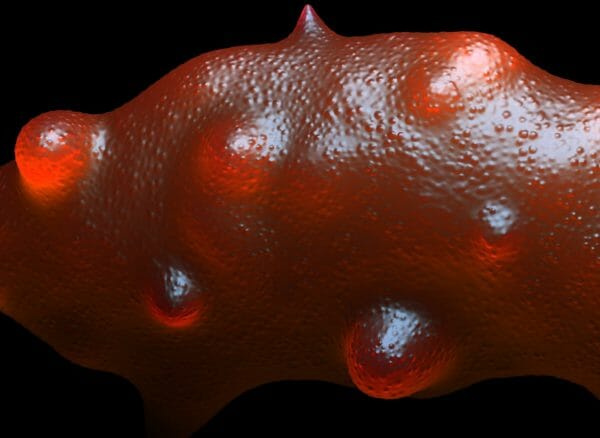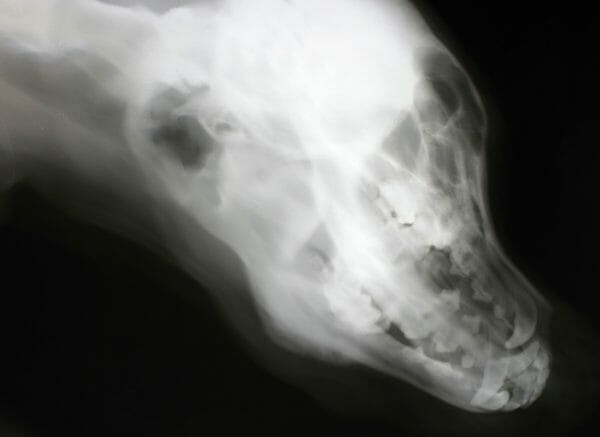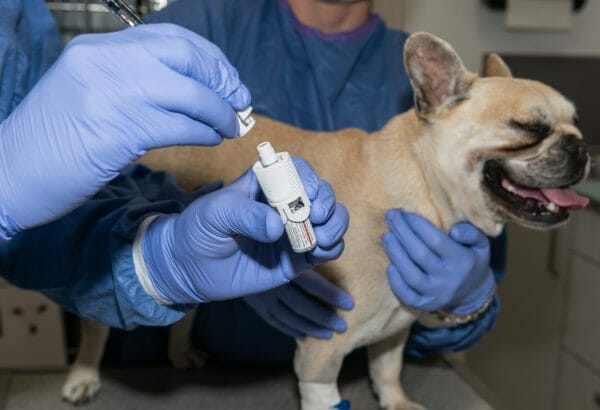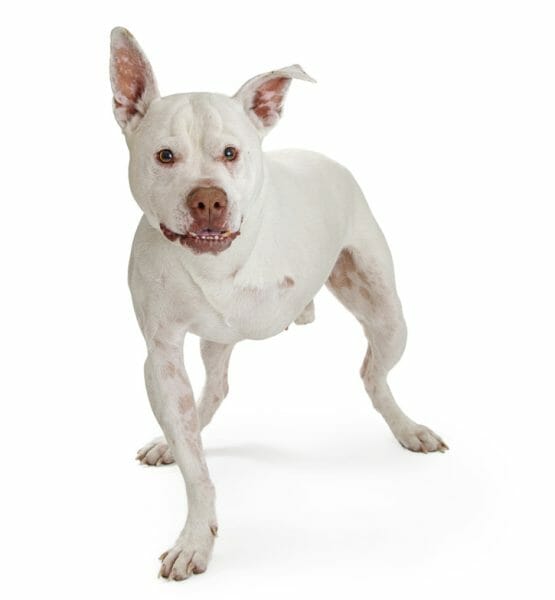What Is Bone Cancer in Dogs?
Bone cancer in dogs can either occur as a primary disease (originating from the cells within the bone) or as a metastatic disease that originates elsewhere in the body.
When such a tumor is present in a dog, it will lead to the painful destruction of bone. It is more typically found in large or giant breeds, such as a Cane Corso or Newfoundlands. Bone cancer must be identified, diagnosed, and treated quickly for the best prognosis. The disease can start as a subtle lameness, misstep, or a lump on the dog’s leg. In some cases, a sudden fracture may occur.
Bone cancer tumors stem from the abnormal production of cells called osteoblasts and osteoclasts. The purpose of these cells is to create and break bones down.

Types of Bone Cancer in Dogs
There are several different types of cancer that may affect a dog’s bones, including:
- Osteosarcoma. The most commonly found type typically affects the dog’s limbs but can also occur in the pelvis, skull, vertebrae, and ribs.
- Chondrosarcoma. Most often found in the ribs or nasal cavity.
- Myeloma. This is a bone marrow cancer in dogs that attacks white cells.
- Fibrosarcoma. This is a type of malignant tumor that originates in the jaw or leg bones.
- Hemangiosarcoma. This type of cancer can comprise the bone’s integrity causing it to fracture
Osteosarcoma accounts for 95% of primary bone cancer in dogs. Primary bone cancer means that it metastasizes in the bones and does not spread from another part of the body.

Symptoms of Bone Cancer in Dogs
Early identification of the signs of bone cancer in dogs is important. The initial signs can be quite subtle. They include:
- A constant lameness and swelling around the affected bone
- A mass or swelling in the ribs, skull, or jaw
- Neurological symptoms, such as a wobbly gait and seizures
- Chewing problems (when the tumor is in the jaw)
- Breathing issues (when the tumor is in the ribs)
- Lethargy
- Loss of appetite
Owners observing any of these symptoms in a dog should make an appointment with a veterinarian as early as possible.
What Causes Bone Cancer in Dogs?
The causes of bone cancer in dogs are not straightforward. Very few types of cancer have a single known cause and could be brought on by a mixture of different risk factors, including hereditary and environmental factors. In the case of dogs that have a genetic predisposition to to the disease, it is thought its development is linked to genes that promote and suppress the growth of tumor cells.

Detecting Bone Cancer in Dogs
To aid the diagnosis process, a veterinarian will generally follow these steps.
- A physical and orthopedic examination will be performed.
- X-ray images of bone cancer in dogs will help rule out other potential reasons for lameness.
- Any areas of potential cancer identified from the X-ray will then be biopsied.
- A computed tomography scan (CT), along with urinalysis and blood tests, will be carried out to determine whether cancer has spread.
Using advanced CT scans will provide a clearer picture of whether surgery will be possible as well as the need for such a procedure.

Dog Bone Cancer Treatment
Due to the aggressive nature of the disease, amputation of the affected limb is common. This will be followed by chemotherapy to treat the metastasis. Most dogs that are otherwise healthy will be able to function well enough on just three legs.
In some circumstances, the veterinary surgeon may be able to spare the limb by carrying out surgery to remove the tumor. In this type of surgery, the bone will be replaced with another, often from a bone bank. Being able to carry out such surgery will depend on the position and size of the tumor. This is often only possible following an early diagnosis. With this limb-saving surgery, there will be a greater risk of complications, such as infection.
Where surgery is not an option, stereotactic radiation (SRS/SRT) may be of benefit. This may be offered as an alternative to amputation where the bone has not yet been destroyed. Using this type of therapy, high doses of focused radiation will be used to kill the cancer cells. Following this treatment, chemotherapy will be required.
SRS/SRT provides doses of radiation with sub-millimeter precision. This means there is less chance of damaging nearby tissue. Typically, results can be achieved in fewer sessions when compared to conventional fractionated radiation therapy (CFRT). Recovery times are also quicker using SRS/SRT and there are fewer associated side effects.
How to Prevent Bone Cancer in Dogs
Although it is not possible to prevent cancer in dogs, owners should be mindful of contributing environmental factors. It is important to avoid exposing a dog to cigarette smoke, excessive sunlight, and dangerous toxins.

What Breeds of Dogs Are Most Prone to Developing Bone Cancer?
Although the disease can occur in any type of dog at any stage in its life, there are some risk factors that can be identified including height, weight, age, and breed. Breeds of dogs that are most prone to developing bone cancer include:
- Great Dane
- Saint Bernard
- Doberman Pinscher
- Boxer
- Irish Setter
- German Shepherd
- Greyhound
- Leonberger
- Rottweiler
- Irish Wolfhound
Owners of these dogs should pay particular attention to the early warning signs for the best prognosis.
Dog Bone Cancer Life Expectancy
The prognosis for dogs with bone cancer will depend on the spread and severity of tumor as well as the treatment provided. Typically, dogs that receive SRS/SRT and chemotherapy will live for around a year. This is a similar prognosis for those treated using amputation and chemotherapy.
When amputation is the only procedure used for bone cancer in dogs, life expectancy without treatment drops to as low as four months. Dogs that do not receive amputation or treatment can expect to live for up to three months.
The end of a dog’s life with bone cancer can be uncomfortable, so palliative care should be provided.



